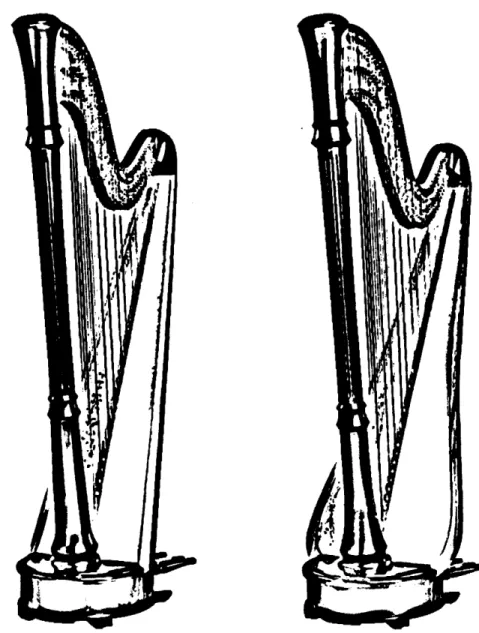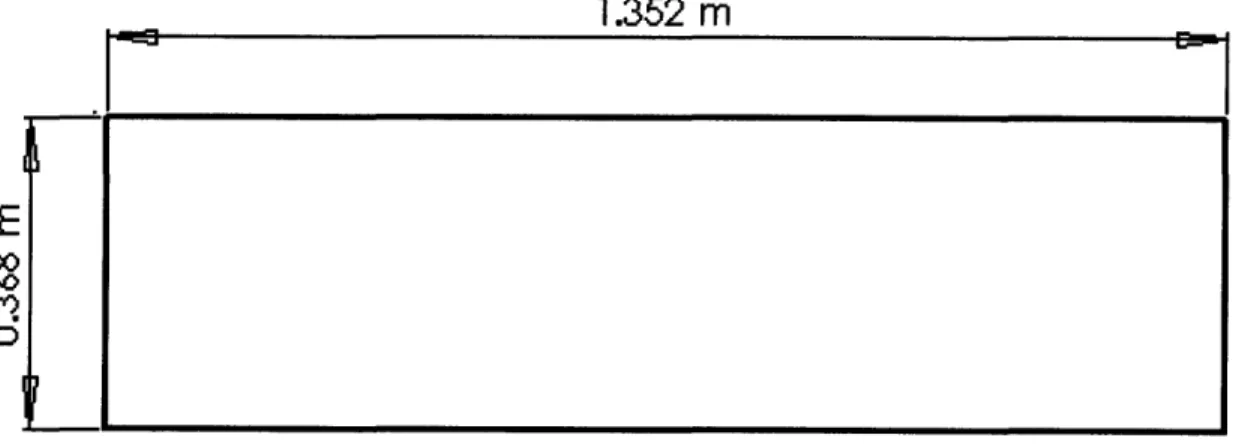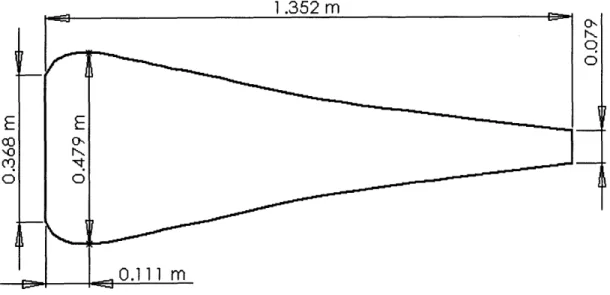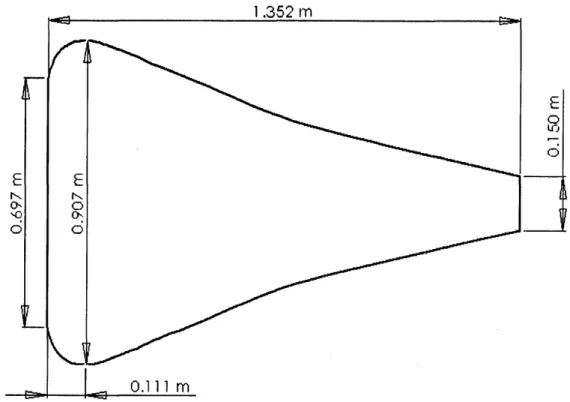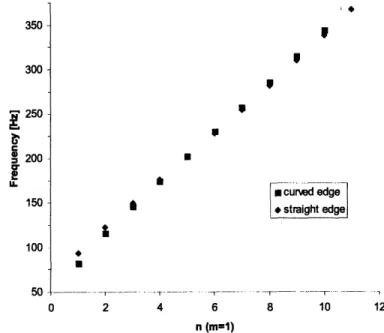Analysis of Natural Frequencies of Concert Harp Soundboard Shapes
by
Katherine L Rorschach
SUBMITTED TO THE DEPARTMENT OF MECHANICAL ENGINEERING IN PARTIAL FULFILLMENT OF THE REQUIREMENTS FOR THE DEGREE OF
BACHELOR OF SCIENCE AT THE
MASSACHUSETTS INSTITUTE OF TECHNOLOGY
JUNE 2007
©2007 Katherine Rorschach. All rights reserved.
The author hereby grants to MIT permission to reproduce and to distribute publicly paper and electronic copies of this thesis document in whole or in part
in any medium now known or hereafter created.
.JX.
f"7)
Signature of Author:/7
C t I V i i b- I-05/-/y7
os/,o/6i
Department of Mechanical EngineeringDate
1Ir %... O01/
'c67
Seth Lloyd Professor of Mechanical Engineering
1- -- •. _Thesis Supervisor Accepted by:-MASSACHUSETTS INTI E OF TECHNOLOGY
JUN 2 1 2007
72"' "I 1 .. 9.f . 5 John H. Lienhard VProfessor of Mechanical Engineering Chairman, Undergraduate Thesis Committee
RCoHo
1
I V
-V - - , % . L.Analysis of Natural Frequencies of Concert Harp Soundboard Shapes
by
Katherine L Rorschach
Submitted to the Department of Mechanical Engineering on May 11, 2007 in partial fulfillment of the requirements for the Degree of Bachelor of Science in
Mechanical Engineering
ABSTRACT
Two possible soundboard shapes for a concert harp were modeled and their lowest natural frequencies compared in order to evaluate the claim that a harp with a bulbous extension has richer sound in the lower notes than one with a simple trapezoidal shape. Two models for the soundboards were evaluated, the first using a stiff plate approximation and the second using a membrane approximation. The lowest modes and frequencies generated by the two models agreed fairly well, and the simpler membrane model was used for the remainder of the analysis. The natural frequencies of an actual harp were determined by impulse response and the frequency spectrum was compared with the modeled frequencies for soundboard and strings. It was determined that many of the important frequencies in the region under 250 Hz could be attributed to the strings. Powerful resonances and clusters coincided with features of the model, indicating that it contains useful qualitative information.
Thesis Supervisor: Seth Lloyd
Introduction
Harps are strung down the middle of a long, flat soundboard of approximately uniform thickness that broadens towards the bottom, where the strings are longer. (Figure 1 shows a schematic of this configuration.)
strine Wlane
Figure 1. String and soundboard configuration on a typical harp. The plane of the strings and the plane of the soundboard meet at right angles, although each individual string is at an angle of 30-40' from the soundboard.
Western concert harps, the largest of the species, may have a soundboard with a bulbous extension to the trapezoidal shape towards the base. Figure 2 compares a harp with a simple trapezoidal soundboard shape to a structurally similar harp featuring a soundboard with the bulbous extension. These images are from photographs of Lyon & Healy Style 85 pedal harps.
r----S
Figure 2. Two structurally similar pedal harps with different soundboard shapes.
This modification increases the cost and complexity of construction significantly. Although craftsmen and musicians believe that it improves the tone of the lower notes, there is no existing analysis that predicts the effect of soundboard shape on overall instrument sound. We will suggest an analytical comparison and evaluate its usefulness with data from an actual harp.
Establishing a standard analysis would be very useful for justifying the increased expense of pedal harps with the larger soundboard shape, as well as for suggesting possible directions for the future design of harps with richer sound, if untraditional construction.
Literature Review
Very little on the structural analysis of harps has been published. In the encyclopedic Physics of Musical Instruments, Fletcher summarizes the few articles published before 1998, the most thorough of which was an experimental study of the soundboard of a small Scottish harp, performed by Firth in 1977. According to Fletcher, Firth found the natural frequencies and mode
shapes of a free soundboard and of the same soundboard after the affixation of a stiffening central plate. (The stiffening plate can be seen on both harps in Figure 2, running down the length of the soundboard and through which the strings are threaded.) After the harp was completely assembled, Firth found the mechanical admittance at different points on the
soundboard where strings were connected. As expected, the natural frequencies after the addition of the stiffening plate were much higher, which we will take into account in our analytical
model. He also found that the lowest frequencies of the free soundboard followed the
progression of Equation 1, while the lowest frequencies of the stiffened soundboard, according to Equation 2.
fn 6 n '7 , n=l, 2, 3, ... Eq. 1 f, n 103n, n=l 1, 2, 3, ... Eq. 2
The other experimental study of the harp noted by Fletcher is a paper by Bell in 1997, which explored the modes of the soundbox and its holes (which are primarily designed for convenience in stringing the harp, rather than acoustics). Bell found that the lowest natural frequency of the soundbox (190 Hz) was higher than the lowest soundboard frequency. Also, all the lower frequencies of the soundbox were significantly coupled to the soundboard frequencies. This finding was followed up in 2007 by another study (Le Carrou) confirming the importance of coupling with the soundbox resonances for at least two important low frequencies. This
complication will be taken into account in our analysis.
Following a different process, Gautier in 2004 measured the sound radiation in different spaces around the harp and found that (as expected) the lower part of the soundboard radiates more than the upper in the lower registers. Gautier also found that the soundbox and soundboard frequencies were coupled in the whole range, supporting the other two sources.
Model
Our approach will begin with a simplification of the problem, justifying our assumptions. Then, using these assumptions, we will determine the natural frequencies of two comparable soundboard shapes. Following this, we will relate the information from the model to data taken from an actual harp. Based on the agreement of data, we will suggest what assumptions can be kept, and what must be discarded for a more accurate future analysis.
To reduce the problem to an appropriate scope, we assume linearity of response. We will model the soundboard as a collection of independent damped spring systems with different natural frequencies. This assumption is necessary for an initial analysis, although we know that it is an oversimplification for a system as complex as a musical instrument (Fletcher).
Our second assumption will require more care. We wish to neglect the effect of harp components other than the soundboard. Studies by Bell, Le Carrou, and Gautier all agree that the soundbox and its holes are significant to the total sound radiation of the harp. Furthermore, the board is in tension with as many as 44 strings. (In a simple experiment, we can observe that plucking one string will set the others in motion to a small extent.) We will have to assume that only some of the frequencies that we measure on the real harp are natural frequencies of the
soundboard itself. Finally, as mentioned in the literature review, harps with large numbers of strings have a stiffening plate glued down the middle, through which the strings pass. One of the few structural analyses of harp soundboards to be published showed that this stiffening plate had a significant effect on the shapes of the natural modes. We will therefore conduct our analysis on half-soundboard shapes as well, essentially modeling the stiff and tensioned central plate as another clamped edge.
The two soundboard shapes that we will model are based on a Lyon & Healy Style 85 Series pedal harp with a Sitka spruce soundboard. This harp has a bulbous extension at the base. Its total length is 1.35 m, the base width is 0.37 m, and the top width is 0.08 m. We will model a
shape as close as possible to the actual footprint, while simplifying the shape by assuming a constant thickness of 0.005 m. (The actual soundboard thickness varies between 0.002 m and 0.008 m.) To make a meaningful comparison to a straight-sided soundboard, the second shape we model will be hypothetical, rather than modeled on an actual straight-sided harp. Our second shape will be a trapezoid with the same total length, base width, top width, and constant
thickness as the curved soundboard.
Harp soundboards can be constructed of almost any wood, although Sitka spruce is common in Western classical harp construction (as in pianos). The harp on which we took impulse response data had a Sitka spruce soundboard, so we will base our model on the material properties of that wood, as reported in Green, compiled in Table 1.
Table 1. Average physical properties for soundboard material.
Symbol Units
Material Sitka spruce
Density p [kg/m3] 350
Young's modulus (longitudinal) EL [MPa] 10890
Young's modulus (radial) ER [MPa] 849
Poisson's ratio (longitudinal-radial) VLR n/a 0.372
Poisson's ratio (radial-longitudinal) VRL n/a 0.040
Woods in general are orthotropic materials, a property which is important to their use in instruments. In a harp soundboard, the fibers are aligned with the length of the board, and the rings (radial direction) are perpendicular to the surface of the board. We will use the terminology that the soundboard's longest dimension will be along the wood's longitudinal direction, the soundboard's width will be along the radial direction, and the thickness will be in the tangential direction. In wooden materials, Young's modulus and Poisson's ratio are significantly higher in the longitudinal direction than they are in the radial direction (i.e. they are much more bendy in the radial direction, which is the width of the soundboard).
In order to use a simple isotropic model, we will scale the width of the modeled shape to account for the orthotropic properties of the wood. Intuitively, the "effective" width of the soundboard should be larger if it is, in reality, more bendy in that direction. According to Fletcher, scaling the non-bendy dimension of a square by a function of the two Young's moduli will produce a rectangle of wood that has the same modes as a square of an isotropic material. (This is detailed in the Methods section with Eq. 9.) We will extrapolate this rule and scale the measured soundboard width by the same amount.
Because it is straightforward to model a membrane of various shapes, we would like to use this method to predict the natural frequencies of a harp soundboard. In a membrane model, the material has no stiffness. The restoring force during deformation is only the perpendicular component of the normal force due to tension. Therefore, the oscillation is defined by:
a2z T
-= -V2z, Eq. 3
where T is the tension and a is the area density. The boundary conditions can be free or pinned (zero displacement).
By contrast, in a thin plate model, the restoring forces are the perpendicular components of both the normal force due to tension and the shear force of deformation. As a result, the governing equation for the oscillation is significantly more complicated.
82Z
Eh2+ V4z = 0 Eq. 4
Dt2 12p(1- v2
Additionally, the boundary conditions for a plate can be free, pinned (zero vertical
displacement), or clamped (zero vertical displacement and zero slope.) In a harp, the soundboard is affixed to the soundbox in a clamped manner, so this is how we modeled the test piece.
To ascertain whether we can use a membrane model to compare soundboard shapes, we will compare the natural frequencies of a rectangular membrane with those of a rectangular thin plate. (A thin plate model, although also a simplification, becomes much more computationally intensive for shapes more complicated than rectangles.) The rectangular test shape we will use is shown below in Figure 3. This shape has the same length and base width as the trapezoidal and bulbous soundboards we would like to model.
1.352 m
E
Figure 3. Geometry of the test shape for comparing membrane and thin plate models. The modeled thickness is 5mm.
For the thin plate model, we use the physical properties of Sitka spruce (shown in the table below). For the membrane model, we use the same geometry and determine the appropriate tension by matching the lowest mode. These properties are all shown in Table 2.
Table 2. Properties for the membrane and thin plate models.
Length Width Thickness Density Elastic Poisson's Tension Lowest
Modulus Ratio frequency
[m] [m] [m] [kg/m3] [MPa] [N] [Hz]
Membrane 1.352 0.697 0.005 350 n/a n/a 13038 69.66
Plate 1.352 0.697 0.005 350 10890 0.372 n/a 69.66
To obtain the natural frequencies of the membrane, we open MATLAB's Partial Differential Equation Toolbox and use the Eigenvalue equation that follows:
I
-
1.352 m
-V.(c.Vz)+a.z = A,-d-z, Eq. 5 where T c=--, Eq. 6 and A
=
2 =(2.,-r
f)2 Eq. 7In equation 4, we set a to zero and d to 1. The other variables are defined by the values in Table 2 and equations 6 and 7. We apply a Dirichlet boundary condition for zero displacement at the edges.
For a rectangular membrane, Equation 3 can also be solved directly for modes m and n (half wavelengths in the y and x directions):
InT
m2
n
2mn Eq.7
This is useful for checking our MATLAB results with the calculated tension.
The program we used to solve the thin plate model for the rectangular test shape is written in MATLAB by Bingen Yang and included with the textbook Stress, Strain, and Structural Dynamics.
The lowest 8 natural frequencies for the test rectangle objects are compared in Figures 4 and 5. Figure 4 shows how the frequencies rise at approximately the same rate. There is a close match on 7 of the modes, but one differs by almost 50 Hz. Figure 5 compares the frequency spectra. The matching is less apparent, although it is clear that the general density of the natural modes is similar.
300 250 200 150
100
50 1 0 o0 membrane modelSthin plate model
1 2 3 4 5 6 7 8
Mode
Figure 4. Frequency progression comparison of the lowest 8 modes of membrane and thin plate rectangle objects.
riembrane model
•in
plate
model
50 100 150 200 250 300
Frequency [Hz]
Figure 5. Frequency spectra comparison of the lowest 8 modes of membrane and thin
plate rectangle objects.
Table 3 lists the frequencies and modes for both the membrane and plate models, showing that the mode numbers are in general the same for the lowest 8 natural frequencies, although 2 are switched (in shaded boxes.)
Table 3. Comparison of the eight lowest natural frequencies for a membrane model vs. a plate model.
mode Plate Hz m n Membrane [Hz] m n
1 69.66 1 1 69.66 1 1 2 90.38 2 1 88.94 2 1 3 128.33 3 1 114.05 3 1 4 180.61 1 2 141.92 1 2 5 183.55 4 1 171.21 2 2 6: 197.62 2 2 201.30 4 1 7 228.64 3 2 231.89 3 2 8 255.59 5 1 262.79 5 1
Having established that the membrane model produces results that are close, but different from, the thin plate model, we are ready to model the actual shapes, knowing to expect this level of error.
Some of the measurements for the actual soundboard on which we are basing the model are shown in Table 4. A top view of the soundboard of this shape is shown in Figure 6.
Table 4. Measurements of the shape of Series 85 concert harp soundboard.
X position [in] Width [in] X position [m] Width [m]
0 3.125 0 0.079375 5 4.42402 0.127 0.11237 10 5.723039 0.254 0.145365 15 7.022059 0.381 0.17836 20 8.321078 0.508 0.211355 25 9.870098 0.635 0.2507 30 11.66912 0.762 0.296396 35 13.96814 0.889 0.354791 40 16.01716 1.016 0.406836 45 18.19118 1.143 0.462056 50 18.2402 1.27 0.463301 52.625 14.5 1.336675 0.3683
dO 10 31 52 m
o(
E 0 0~-q 0Figure 6. Actual soundboard shape for a Series 85 concert harp.
A comparable straight-sided soundboard would have the same length, base width, and top width (as suggested by Figure 2.) This hypothetical soundboard is shown in Figure 7.
1.352 m E 0
I
I
E
0o, (d IcFigure 7. Hypothetical soundboard shape for comparison.
As previously mentioned, we plan to deal with the orthotropic nature of wood by scaling the shape. Due to the way musical instruments are built, the soundboard in Figure 7 above would be more bendy along the shorter dimension - that is, it would behave as if it were effectively longer in that direction. According to Fletcher, we can scale the measurements in the y-direction according to Equation 9 in order to use the longitudinal Young's modulus in both directions.
1.352 m 0.111 m
,jIIIIIIII
P ... ý ý ý I ý 'p, _ Pý IEaw
i
I I
E x
Yeffctie
"
EY
According to the physical values in Table 1, this scaling factor is 1.89. The two shapes to be modeled become the two shapes shown in Figures 8 and 9.
1 k) mrn
Figure 8. Scaled actual bulbous soundboard from Series 85 concert harp.
E
C
(3· ".o
d
Figure 9. Scaled hypothetical straight-sided soundboard for comparison.
Results
We used the Partial Differential Equation Toolbox in MATLAB on the shapes shown in Figures 8 and 9, using the physical values in Table 2. The progression of natural frequencies below 875 Hz for both shapes are compared in Figure 10. As expected, the frequencies for the bulbous shape are lower than those for the straight-sided shape. Furthermore, the natural frequencies for the curved shape rise at a lower rate.
850 800 -750 700 650 600-550 500 450 400 350 300 250 -200 150 IU - .. r··
7."
... .,.
curved
edge
** straight edge 100 Mode 150 150 200Figure 10. Frequency progression soundboard shapes.
comparison of the natural frequencies of the two
The two spectra are compared in Figure 11. The bul natural frequencies in the range shown, as we expect.
bous shape has a higher density of
-straight edge
_--
--.
curv• edege
0 100 200 300 400 500 600 Frequency [Hz]
Figure 11. Frequency spectra comparison of the natural soundboard shapes.
700 800 900
The lowest modes for mode number m=l (one half wave in the y direction) are compared in Figure 12. The lowest modes for m=2 (one full wave) and m=3 (one and a half waves) are shown in Figures 13 and 14. We can see that the differences are more apparent for higher m modes. We can justify this observation by noting that the effect of the increased width would be most apparent for higher mode numbers in that direction.
350300 - '250-200 .0 u. 150 -100 --1 - - . . . . . . 2 4 6 n (m=1) *cured edge *straight edge 8 10 12 8 10 12
Figure 12. Mode-by-mode comparison of m=1 modes of the two shapes.
350
-
3001
250
200
150 * cured edges straight edge
100
05
0 4
n (m=2)
Figure 13. Mode-by-mode comparison of m=2 modes of the two shapes. D;U
350 300 250 " 200 0. 150 100 50 * cuned edge * straight edge n (m=3)
Figure 14. Mode-by-mode comparison of m=3 modes of the two shapes.
As we observed earlier, and as noted by other analyses, the stiffening plate and tensioned strings down the middle of the board have a significant effect on the natural frequencies. In order to take this into account, we will modify the above analysis by considering half shapes that are clamped on all sides, as shown in Figures 15 and 16.
Figure 15. Scaled bulbous soundboard from Series 85 concert harp.
1
.35 2
miFigure 16. Scaled hypothetical straight-sided soundboard for comparison.
Repeating the previous analyses, we have the following corresponding comparisons. Figure 17 compares the two half soundboard shapes, and Figure 18 shows them on the same graph with the symmetrical soundboard shapes. The m=1 mode shapes for the half soundboards should correspond to the m=2 mode shapes for the whole soundboards. Comparison of Figures 13 and 20 shows that this is the case.
ii
850 ***,0, 00 800 o°o0" 750 700- ." 650 O" 600 aao0 to - 550 **,.I"8 N oo 500 0 O 450 oeG 5 400 ... 2350 300 060 250 1 o
straight edge (half)
200 * curved edge (half)
200 o j 150 100 50 0 0 10 20 30 40 50 60 70 80 Mode
Figure 17. Frequency progression comparison of the natural frequencies of the two soundboard shapes.
850
]
800-750 700 650 600 - 550 500450-8
400 2 350u. 3 300 - ; straight edge (half)
250 • curved edge (half)
200 . straight edge (symmetric)
150 curved edge (symmetric)
100
50 0
0 50 100 150 200
Mode
Figure 18. Frequency progression comparison of the natural frequencies of the two soundboard shapes. ~...~··· ~~~ .... .. ,..~··" .··'' ··· .~.''''' .~·'' .=
100-100 -straight edg - - curved edge 200 300 400 500 600 700 800 Frequency [Hz]
Figure 19. Frequency spectra comparison of the natural frequencies of the two half-soundboard shapes. 500 450 400 350 300 250-200 150 100 50 Scured edge L* straight edge 2 4 6 8 10 12 14 n (m=1)
Figure 20. Mode-by-mode comparison of m= 1 modes of the two shapes.
. U * U U 500 450 "
400
j
350 300 250 200 150 100 500 .
0 4 n (m=2)Figure 21. Mode-by-mode comparison of m=2 modes of the two shapes.
500
450 400 350 300 250 200 150scurvededge
l * straight edge n (m=3)Figure 22. Mode-by-mode comparison of m=3 modes of the two shapes.
Experimental Method
To relate our model to actual harp sound, we took the impulse response of a harp with a soundboard of the shape in Figure 5. The natural frequencies were found by fast Fourier
transform of the sound recording.
I curv_ d edge * straight edge 50 i 0 II
The experimental set-up is shown in Figure 16. A microphone was positioned over the lower part of the soundboard and connected to a LABPRO module and a computer. The recording was takem at various sampling frequencies (three trials each at 500 Hz, 1000Hz, 2000Hz, 5000Hz, 10000Hz, 20000Hz, and 50000Hz). The impulse was applied by rapping a knuckle on the soundboard after the recording started. A fast Fourier transform was applied in the Logger Pro program, and the data was transferred to Microsoft Excel and MATLAB for further analysis.
Figure 23. Frequency spectrum for impulse response sampled at 50000Hz.
Our recordings at higher sampling frequencies, such as the 50000 Hz recording whose frequency spectrum is shown in Figure 16, showed that the most important frequencies were less than 1000 Hz. This justifies our focus on the lower frequencies. As in the published studies, we examined only the very lowest of these frequencies: using data taken at 500 Hz, we considered the represented frequencies lower than 250 Hz.
0 5000 10000 15000 20000 25000
Frequency [Hz]
Figure 24. Frequency spectrum for impulse response sampled at 50000Hz, showing the importance of the lowest natural frequencies.
Two samples taken at 500 Hz are shown in Figure 25, and indicate that we get repeatable results for the most important frequencies. Although these recordings are not normalized for volume, it appears that background noise only contributes one important frequency below 250 Hz that we should be aware of.
-- impulse response 1
impulse response 2
-
background0 50 100 150 200
Frequency [Hz]
A frequency spectrum of the background noise is superimposed on Figure 25 because recordings were not taken in a soundproof room. In the region under 250 Hz, there is only one important frequency that may be due to background noise (at approximately 60 Hz).
Discussion
The frequency spectrum we observe experimentally is much more complex than the few resonances predicted by our model. This is reasonable, given that we expect to see important frequencies contributed by the strings, soundbox, and other structural features of the harp, in addition to those of the soundboard.
By superimposing the expected string frequencies on the observed frequency response, as in Figure 26, we notice a correlation between these and many of the important experimental resonances. The matches are not perfect, possibly due to the fact that the experimental harp had not been recently tuned. However, many of the resonances in the region above 100 Hz, where the notes lie farther apart on the frequency spectrum, are probably due to the strings. We also note that the frequencies we suspect of representing strings have characteristic amplitudes in the middle region of Figure 26.
-impulse response 1 - impulse response 2
b k1
string frequenciesi~iiili
1 i1
I. i I I lllll [ I I IllJtllII
1
I I iIii1
u 50 100 150 250 Frequency [Hz]Figure 26. Frequency spectra for impulse response superimposed on theoretical string frequencies.
There are several resonances (and resonance clusters) more powerful than the majority of string resonances. In Figures 27 and 28, we superimpose the expected half and whole
soundboard frequencies on the observed data and string frequencies. These powerful resonances U•IL; I•tJI UUl lU ]
.... st n'_ng fieq us n ci es_ _• I I I
I
i I
1I
I
I1
.. .. - -- ------and clusters tend to lie near both expected string ---and expected soundboard frequencies, suggesting that the soundboard plays a role in amplifying those frequencies.
50 100 150 200
Frequency [Hz]
Figure 27. Theoretical half soundboard response spectra.
impulse response 1
impulse response 2
-background string frequencies -whole soundboard frequencies
'III
~
111
LLaM
and string frequencies superimposed on impulse
~I
iMil
Frequency [Hz]
Figure 28. Theoretical whole soundboard and string frequencies superimposed on impulse response spectra.
I~
Four of five half soundboard frequencies (Figure 27) and ten of twelve whole soundboard frequencies (Figure 28) lie near significant resonances. Although there are a few modeled
frequencies that are not represented in the experiment, the correlation between measured and observed resonances is somewhat strong. Additionally, the cluster of observed resonances at approximately 225 Hz and 175 Hz also occur near clusters of expected natural frequencies for the whole soundboard model. This correlation between the model and the experiment indicates that even the simple soundboard model of this study includes significant qualitative information about the natural frequencies of the harp.
Conclusion
Our model suggests that a bulbous soundboard has a higher density of lower natural frequencies than a straight sided soundboard; additionally, it provides at least one lower natural frequency than any in a straight-sided soundboard. Given the experimental results showing the importance of the very lowest natural frequencies, this does not contradict the belief that the bulbous extension enriches the overall sound. Our experimental results also show significant matches with expected string frequencies; significantly, the strongest resonances and clusters
occur around expected soundboard frequencies. This simplistic model can make no predictions about specific frequencies, but it may be the easiest way to predict in a qualitative manner the features of a harp soundboard frequency spectrum.
Acknowledgements
The author would like to thank Professor Seth Lloyd of MIT for help in designing and carrying out this project, and also Robert Rorschach for technical assistance in taking the
experimental measurements.
References
Green, David W., Jerrold E. Winandy, and David E. Kretschmann. "Mechanical Properties of Wood." Wood Handbook: Wood as an engineering material. Chapter 4, Forest Products Laboratory. Madison, WI. U.S. Department of Agriculture, Forest Service. 1999.
Fletcher, Neville H. and Thomas D. Rossing. The Physics of Musical Instruments. New York: Springer, 1998.
Gautier, F. and N. Dauchez. "Acoustic intensity measurement of the sound field radiated by a concert harp." Applied Acoustics. Volume 65 (2004), p 1221-1231.
Le Carrou, J-L., F. Gautier, and E. Foltete. "Experimental study of AO and T1 modes of the concert harp." Journal of the Acoustical Society ofAmerica. Volume 121, issue 1, January 2007. 559-567.
Yang, Bingen. Stress, strain, and structural dynamics: an interactive handbook offormulas, solutions and MATLAB toolboxes. Boston: Elsevier Academic Press, 2005.

